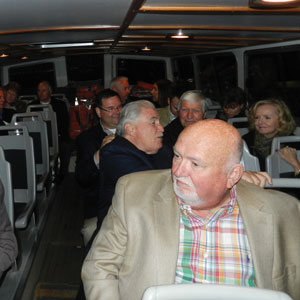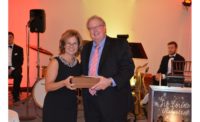
|
|
A group including Sean O’Keefe of Texana, Ron Davis of the Davis Group;, Mel Mahler of ADS, Mark Melendes of the Private Bank, past CSAA president Bud Wulforst, Sheriff Paul Fitzgerald, Don Young from Protection One, and Tom Few of Vivint returns to the event hotel after a group dinner on a Venetian “water bus.” PHOTO BY KEITH JENTOFT |
Once a year, the forces of government that most affect our industry converge — and you are invited to attend. The leadership of the International Association of Chiefs of Police (IACP), the National Sheriffs Association (NSA), International Fire Chiefs Association (IFCA), and Association of Public-Safety Communications Officers (APCO) come together at the CSAA annual meeting to work with the security industry on areas of concern. Panel discussions and individual presentations by these leaders highlight the annual meeting. This year these groups met in Venice, enjoying the history, sights and food of one of the most beautiful cities in the world. In addition to the business meetings, there were organized tours and receptions scheduled where anybody attending could meet and mingle with the authorities having jurisdiction (AHJs).
The focus of attention this year was undoubtedly the ASAP project spearheaded by outgoing CSAA president, Ed Bonifas. ASAP stands for the Automated Secure Alarm Protocol that creates an electronic link between the central station and the PSAP/911 center so that the monitoring station can send alarm data directly to the dispatcher and eliminate the traditional three minute phone call between the central station operator and the 911 call-taker. From the podium, the AHJs were unanimous in their approval of this new electronic link between the security industry and the 911 center or pubic safety answering point (PSAP). They viewed this new electronic data link as a crucial step forward to work together improving public safety.
Another highlight was a report on the revitalized Insurance Liaison Committee given by Ed Bonifas. After years of decay, video alarms and priority response have begun to revolutionize the historical partnership between the insurance/security industries — by delivering arrests and controlling loss for insurers. Today’s insurers believe that strong security/law enforcement relationships built on new technologies have tangible value in controlling loss. In fact, NSA President Sheriff Paul Fitzgerald, mentioned Videofied three times during his conference presentation, explaining that video alarm systems certainly help law enforcement be more effective in an era of shrinking budgets. Phase two of ASAP will build upon this momentum and deliver streaming video to first responders.
A third point in the AHJ discussions focused on mutual goals in the current round of the NFPA 72 fire standard modifications. Both the security industry and the fire chiefs are pushing NFPA to adopt the benefits of improved technologies and communications, but the NFPA review process has stymied much of the requested evolution. Both parties believe that the NFPA 72 standard simply doesn’t reflect the current state of the art. Together, the IAFC and the CSAA announced the launch of a jointly funded study designed to provide the hard data needed to move the standard forward.
CSAA presented the 2011 Stanley Lott Award to Pam Petrow for her years of work developing ASAP. The annual meeting culminated with a black-tie dinner and Robert Bean, of Alert Alarm of Hawaii, taking the gavel from Ed Bonifas as the next CSAA president. To read more about the Stanley Lott award and Bean’s appointment see “CSAA Names New President, Stanley C. Lott Award Winner” on page 28.



